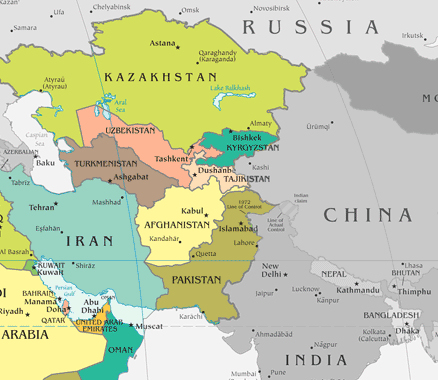It seems that everywhere we look these days- from U.S. shale to massive Turkmenistan reserves- natural gas seems to be the energy source of the future.
Back in 2006 Turkmenistan claimed to have found a field of up to 24 Trillion Cubic Meters of natural gas. At the time BP was saying that the reserves were probably less than 1/10th the amount. Since then the Chinese have been nailing down reserves left and right and it appears that these reserves may be twice as large as originally thought. Unfortunately, the U.S. has been woefully slow to catch on to the Chinese game.
But recently Hillary Clinton got around to sending an envoy to Turkmenistan trying to catch up with the Chinese. 
Turkmenistan Gas Finally Gets Washington’s Attention – A Little too Late
One of Washington’s key policy tenets since the 1991 collapse of Communism has been to pry out from under Moscow’s control as much of the energy assets of the post-Soviet space as possible.
Nowhere has this policy been more evident than in the Caspian basin and the energy riches of the new post-Soviet states of Azerbaijan, Kazakhstan and Turkmenistan. To the north lies Russia, with whom Washington jostles for these assets while Iran rings the Caspian’s southern shore, a rogue “axis of evil” member state that Washington has been punishing with sanctions on its energy sector since well before the Evil Empire collapsed.
Now, in a stunning example of naïve hope over geopolitical and economic reality Washington is wooing Turkmenistan, hoping to get a slice of the pie of the world’s fourth or fifth-largest natural gas deposits.
What caused the drooling in Beltwayistan was the release in May of a report by the respected British audit firm Gaffney, Cline and Associates on Turkmenistan’s gas reserves. The report concluded that the South Yolotan natural gas superfield, discovered in 2006, contains reserves of more than 20 trillion cubic meters of natural gas, enough to satisfy European demand for more than 50 years and making it the second largest gas field ever found. It should be noted here that when in 2006, following the field’s discovery, Turkmenistan’s megalomania cal ruler, Saparmurat “Turkmenbashi” Niyazov claimed that the discovery boosted the country’s reserves up to 24 trillion cubic meters of natural gas, his claims were taken as mere braggadocio, with BP calculating them at slightly more than 1/10th that amount. A similar thing happened two years later, when Gaffney, Cline and Associates first audited South Yolotan, and their findings were initially ridiculed as overstated.
Who’s laughing now?
Secretary of State Hillary Clinton’s special envoy on Eurasian Energy, Ambassador Richard L. Morningstar was hurriedly dispatched to Ashgabat, where on 14 June he met with Turkmen President Gurbangeldy Berdymukhammedov after which he gurgled, “The U.S. praises the energy policy of Turkmenistan and its positive initiatives relating to global energy security and the development of broad international cooperation.”
Perhaps Morningstar’s staffers forgot to remind him that early last year Turkmenistan inaugurated two new pipelines to China and Iran that have given Turkmenistan additional export routes for its gas. If the special envoy felt that he had maneuvering room with Berdymukhammedov, it was because the Turkmen ruler is reportedly still annoyed with Gazprom, which unilaterally drastically cut its imports of Turkmen gas on 9 April 2009, causing an explosion at the 302nd-mile segment of the Soviet-era Truboprovodnaiia sistema Sredniaia Aziia-Tsentr (the Central Asia-Center, or SATS, pipeline system) SATS-4 Davletbat-Daryalik pipeline between the Ilyaly and Deryalyk compressor stations near the Turkmen-Uzbek border, halting Turkmen natural gas exports to Russia, which had been running at 42-45 billion cubic meters (bcm) per annum. Gazprom only resumed imports in January 2010, but at a much reduced level. While the new Chinese and Iranian lines have picked up some slack, the Turkmen government still remains angry with Gazprom for the reduced revenue stream.
Even assuming that Morningstar’s diplomatic charms are sufficient to woo Berdymukhammedov to consider gas exports westwards, there remains the small issue of dividing the Caspian’s offshore wasters and seabed, a niggling legacy of the collapse of the USSR two decades ago. Briefly put, Russia favors a solution whereby the five Caspian states receive allotments proportional to their coastline, while Iran is holding out for an equitable 20 percent division for all.
Despite their diplomatic distance however, there is little doubt that both Russia and Iran would oppose the construction of any such undersea Caspian pipeline linking Turkmenistan and Azerbaijan, and the military and diplomatic pressure they could bring on their neighbors would and could be formidable.
Oh, and did I mention that on 30 June that China announced its second pipeline with Turkmenistan, a $22 billion, 5,370 mile pipeline with an annual capacity of 30 bcm had begun operations and that Beijing is on target to replace Russia as Turkmenistan’s leading export market within a few years?
It would seem that Morningstar landed in Ashgabat more than a few days late and a few rubles – err, yuan, short.
By. Dr. John C.K. Daly for OilPrice.com. For more information on oil prices and other commodity related topics please visit www.oilprice.com
